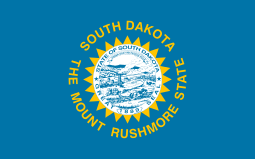William J. Bulow
| William John Bulow | |
|---|---|
 | |
| United States Senator from South Dakota | |
|
In office March 4, 1931 – January 3, 1943 | |
| Preceded by | William H. McMaster |
| Succeeded by | Harlan J. Bushfield |
| 12th Governor of South Dakota | |
|
In office January 4, 1927 – January 6, 1931 | |
| Preceded by | Carl Gunderson |
| Succeeded by | Warren Green |
| Member of the South Dakota Senate | |
|
In office 1899 | |
| Personal details | |
| Born |
January 13, 1869 Moscow, Ohio |
| Died |
February 26, 1960 (aged 91) Washington, D.C. |
| Political party | Democratic |
| Spouse(s) |
|
| Alma mater | University of Michigan |
| Profession | Attorney |
| Religion | Lutheranism |
William John Bulow (January 13, 1869 – February 26, 1960) was an American politician and a lawyer. He was the first Democratic Governor of South Dakota, receiving the highest vote ever received by a Democratic candidate for governor up to that time,[1] and then went on to serve as a member of the United States Senate.
Biography
Bulow was born of German ancestry to Joseph and Elizabeth (Ebendorf) Bulow near Moscow in Clermont County, Ohio, where he was raised and educated. In 1893, he graduated with a law degree from the University of Michigan.[2] He was twice married - to Katherine J. Reedy and to Sarah (Johnson) Farrand.[3]
Career
During 1893, Bulow moved to South Dakota. He resided in Sioux Falls, where he worked for the Joe Kirby office. Then, he came by horse and carriage to Beresford, where he set up his own law office and helped to develop the town. He was elected to the state senate of the South Dakota Legislature in 1898.[1] While residing in Beresford, Bulow spent twenty-five years as city attorney from 1902 to 1927, except while serving as mayor from 1912 to 1913. He also served as County Judge for Beresford in 1918. Bulow ran unsuccessfully for governor in 1924, but won in 1926,[1] and served as Governor of South Dakota from 1927 to 1931 and as a member of the US Senate from 1931 to 1943. As governor, he pardoned the famous frontier gambler Poker Alice after her conviction of bootlegging and other charges related to running a house of prostitution.
During his entire life, Bulow kept a legal residence in Beresford, South Dakota and voted by absentee ballot. He was defeated for renomination for a third term in the South Dakota Democratic primary by former Governor Tom Berry. Buhlow then retired and spent the rest of his life residing at 3901 Connecticut Avenue NW in Washington, D.C. Bulow spent his last few years in failing health and was blind during his last four years. He was a member of the Alfalfa Club.[4]
Beresford honored William J. Bulow in 1959 during the town's seventy-five year jubilee observance. The city's park was dedicated as "Bulow Park" on June 3, 1959.
Death and legacy
Almost nine months later, Bulow died in Washington D. C. District of Columbia, USA;[5] and, his body was returned to Beresford for burial at the St. John Catholic Cemetery, where he was interred next to his first wife, Katherine (Reedy) Bulow (January 29, 1875 – September 17, 1918). Years later, Bulow's house in Beresford, South Dakota was declared a historic landmark (Governor William J. Bulow House).
References
- 1 2 3 South Dakota Manual, 1927, p.235
- ↑ "William J. Bulow". National Governors Association. Retrieved 18 October 2012.
- ↑ "William J. Bulow". National Governors Association. Retrieved 1 September 2012.
- ↑ Alfalfa Club
- ↑ "William J. Bulow". Find A Grave. Retrieved 1 September 2012.
External links
| Wikimedia Commons has media related to William J. Bulow. |
- United States Congress. "William J. Bulow (id: B001055)". Biographical Directory of the United States Congress.
- William J. Bulow's NNDB biography
- Listing for William J. Bulow's home on the National Register of Historic Places
- National Governors Association
| Political offices | ||
|---|---|---|
| Preceded by Ole Ofstad |
Mayor of Beresford, South Dakota 1912–1913 |
Succeeded by S. O. Steensland |
| Preceded by Carl Gunderson |
Governor of South Dakota 1927–1931 |
Succeeded by Warren Green |
| United States Senate | ||
| Preceded by William H. McMaster |
United States Senator (Class 2) from South Dakota 1931–1943 |
Succeeded by Harlan J. Bushfield |

